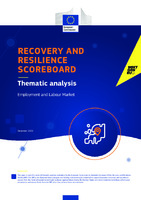Recovery and resilience scoreboard. Employment and Labour Market.

thematic analysis
Συγγραφέας
European Commission
Ημερομηνία
2021-12Προβολή/
Θεματικές επικεφαλίδες
Green transition ; Digitalisation ; Globalisation ; DemographicΠερίληψη
In spite of a major drop in GDP in 2020, comprehensive policy measures swiftly adopted at the national and EU
level contributed to cushioning the labour market impact of the pandemic. Overall, job losses in 2020 have been
limited compared with those observed during the 2008 financial and economic crisis, thanks to the short-time work schemes
and similar job retention measures put in place. The EU economy rebounded strongly in 2021 and the average unemployment
rate has recently decreased below 7%, close to the pre-crisis level (6.6% in Q4 2019). Unemployment remains however signif-
icant in some Member States, with rates still above or close to 10% in some Member States. The employment rate (20-64)
has recovered partially to 72.8% in Q2 2021 but is still slightly below the Q4 2019 peak (73.4%). With women overrepre-
sented in several occupations that were vital and required for continuous work during the crisis, employment rates during
the crisis dropped more for men than for women, reducing slightly the gender employment gap, which remains nonetheless
large (11%). Overall, employment is projected to increase by 0.8% in 2021 and by 1% in 2022, followed by a more modest
increase of 0.6% in 2023.
